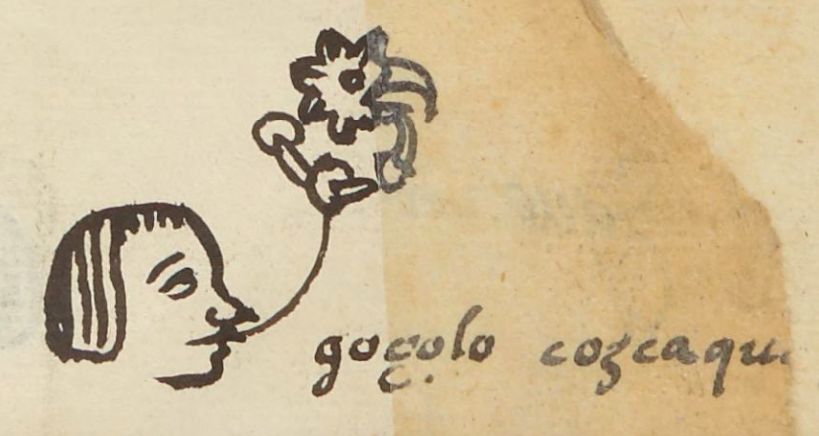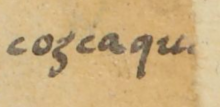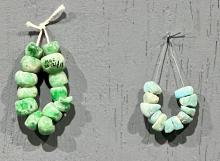Cozcacuauh (MH484r)
This is a compound glyph for the personal name Cozcacuauh ("King Vulture," attested here as a man's name). The gloss is cut off, so perhaps the name is Cozcacuauhtli, with the absolutive, but other examples of Cozcacuauh point to that abbreviated version. The glyph components include the head of an eagle (cuauhtli) shown in profile, facing to the viewer's right. Its eye is open, its beak is slightly open, and it has dark feather tufts surrounding its face. Below this head is a simple necklace (cozcatl), circular, with three beads strung on perhaps a leather thong. Everything is drawn with black lines and no additional colorants.
Stephanie Wood
The necklace does not have a semantic contribution; it provides the phonetic "cozca" that is the start of the word for vulture. Otherwise, the person'a name might be mistaken for simply "Cuauh," Eagle. Thus, this compound comprises two phonograms.
Cozcacuauhtli is a day sign in the tonalpohualli, the 260-day divinatory calendar. Normally, the vulture would have a numerical companion from 1 to 13, but the number has been inadvertently dropped or suppressed. Calendrics figure importantly in Nahuas' religious views of the cosmos.
Stephanie Wood
cozcaqu...
Cozcacu[auhtli]
Stephanie Wood
1560
Stephanie Wood
eagles, buitres, águilas, collares, necklaces, nombres de hombres
These beads are located in the Regional Museum of Guadalajara. The strings are not the originals. Presumably these strands represent chalchihuitl (green) and xihuitl (turquoise), but the distinction between blue and green is not always hard and fast. (Photo by Stephanie Wood, 4 February 2025.)

cozcacuauh(tli), a vulture and other birds, https://nahuatl.wired-humanities.org/content/cozcacuauhtli
cozca(tl), necklace, https://nahuatl.wired-humanities.org/content/cozcatl-0
cuauh(tli), eagle, https://nahuatl.wired-humanities.org/content/cuauhtli
Buitre
Stephanie Wood
Matrícula de Huexotzinco, folio 484r, World Digital Library, https://www.loc.gov/resource/gdcwdl.wdl_15282/?sp=47&st=image&r=-0.559,-....
This manuscript is hosted by the Library of Congress and the World Digital Library; used here with the Creative Commons, “Attribution-NonCommercial-ShareAlike 3.0 License” (CC-BY-NC-SAq 3.0).








